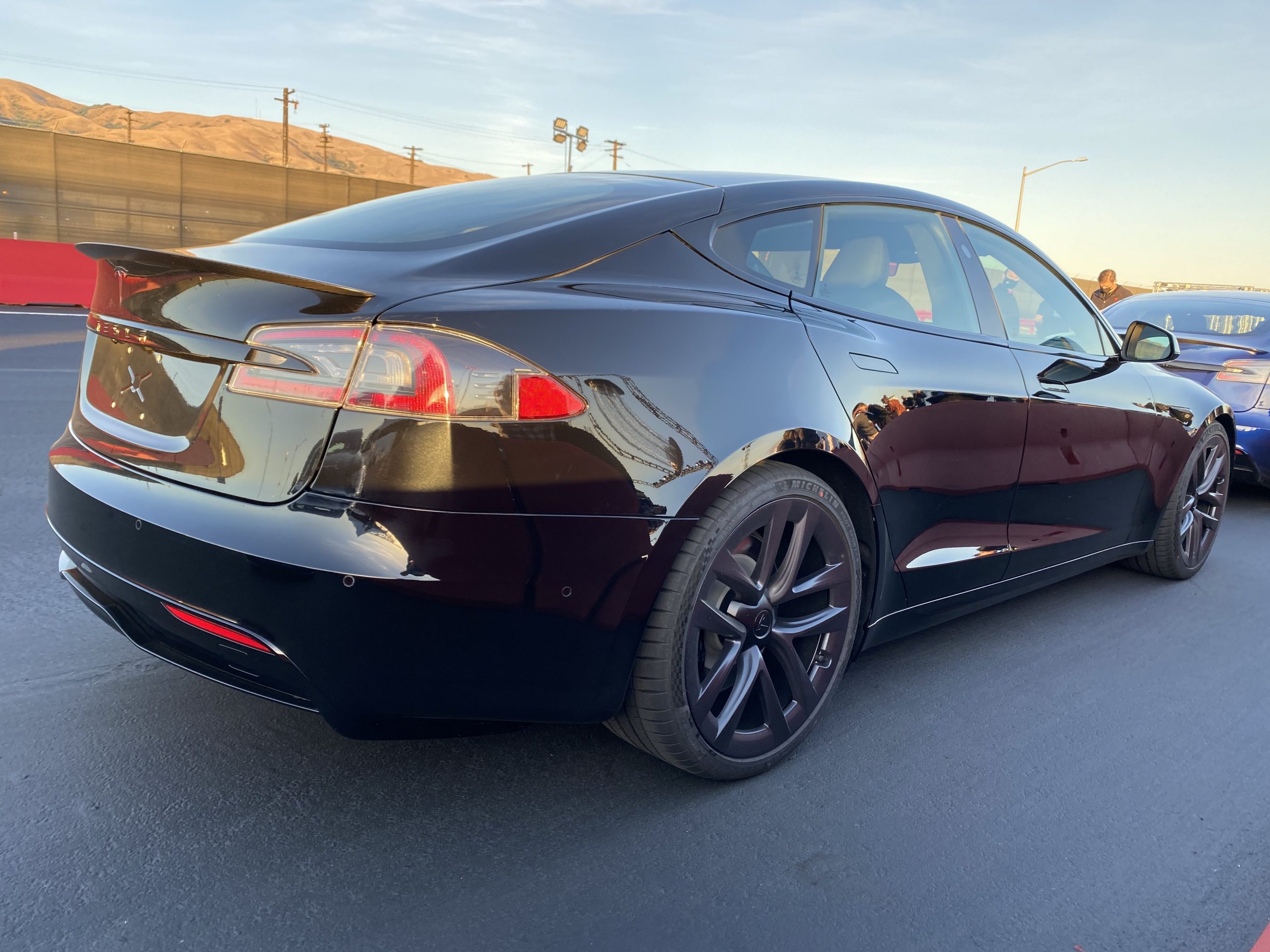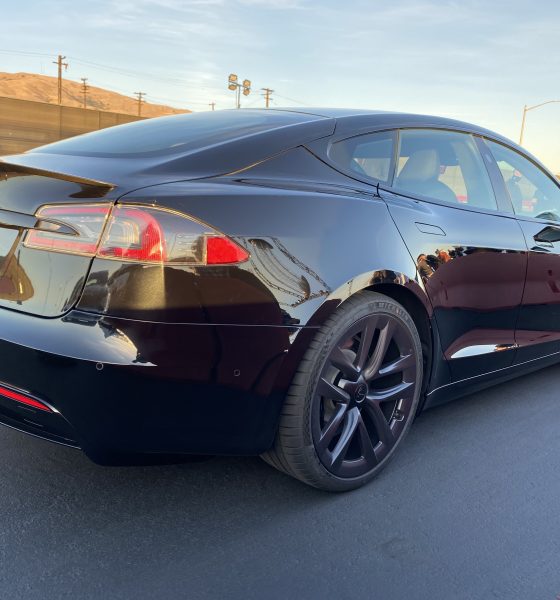

News
Tesla Model S Plaid at 50% charge pulls faster than supercars, data shows
During the reign of the Tesla Model S Performance, P100D, P90D, and P85D, electric car critics typically pointed out that the flagship sedan could only achieve its peak performance when the car was fully charged. Critics stated that once the top-tier Model S’ battery dropped to about 50%, drivers should expect a notable drop in performance.
The Model S critique was one of the likely reasons why Porsche highlighted the Taycan’s capability to post consistent 0-60 mph and quarter-mile times regardless of its state of charge. Tesla decided to change the narrative with the Model S Plaid’s performance eventually. The company later noted that the flagship sedan could now post consistent performance figures even as its state of charge decreased.
Data from drivers who have taken delivery of the Model S Plaid has since proven Tesla’s claim. But that’s not all. As per a recent video from Brooks Weisblat, from YouTube channel DragTimes, Model S Plaid with only 50% state of charge could accomplish a full quarter-mile run in the mid-9 seconds. With those results, the Model S Plaid is faster than some of the world’s best supercars today and significantly faster than the Porsche Taycan Turbo S.
The DragTimes host was able to get Dragy data from two separate Model S Plaid owners who launched their cars in regular roads. One of the vehicles had a 98% state of charge, while the other only had 50% of its battery charged. Remarkably, the Model S Plaid posted relatively similar times. The vehicle with 98% charge completed the quarter-mile in 9.39 seconds and the car with just 50% battery finished the same run in 9.56 seconds.
Even more notable, the Model S Plaid with 50% battery actually posted a better 0-60 mph time of 2.38 seconds than the vehicle with 98% charge, which posted a 0-60 mph time of 2.42 seconds. The trap speed of the vehicles at the quarter-mile mark was not too far apart either. The vehicle with 98% battery hit the quarter-mile mark at 152.43 mph and the Model S Plaid with 50% battery hit the same mark at 146.64 mph.
Being a drag racing enthusiast, Weisblat has tested some of the world’s fastest supercars on the quarter-mile. Just like the two Model S Plaid owners who posted their Dragy data, the YouTube host also tested a number of supercars on the street for their real-world performance, including the Ferrari SF90, the McLaren 765LT, the Lamborghini Huracan Evo, and the Porsche Taycan Turbo S. Each of these vehicles’ quarter-mile times were not as impressive as the Model S Plaid with 50% state of charge.
The Ferrari SF90, for example, completed its quarter-mile in 9.64 seconds. The McLaren 765LT, one of the supercar maker’s best quarter-mile vehicles, completed the same run in 9.88 seconds. The Lamborghini Huracan EVO, on the other hand, finished the quarter-mile in 10.44 seconds, while the Porsche Taycan Turbo S completed the run in 10.39 seconds. This is an incredible achievement for the Model S Plaid, and it speaks to the vehicle’s consistent performance.
Watch DragTmes‘ video on the Model S Plaid’s real-world quarter-mile times in the video below.
Do you have anything to share with the Teslarati Team? We’d love to hear from you, email us at tips@teslarati.com.

News
Tesla starts showing how FSD will change lives in Europe
Local officials tested the system on narrow country roads and were impressed by FSD’s smooth, human-like driving, with some calling the service a game-changer for everyday life in areas that are far from urban centers.

Tesla has launched Europe’s first public shuttle service using Full Self-Driving (Supervised) in the rural Eifelkreis Bitburg-Prüm region of Germany, demonstrating how the technology can restore independence and mobility for people who struggle with limited transport options.
Local officials tested the system on narrow country roads and were impressed by FSD’s smooth, human-like driving, with some calling the service a game-changer for everyday life in areas that are far from urban centers.
Officials see real impact on rural residents
Arzfeld Mayor Johannes Kuhl and District Administrator Andreas Kruppert personally tested the Tesla shuttle service. This allowed them to see just how well FSD navigated winding lanes and rural roads confidently. Kruppert said, “Autonomous driving sounds like science fiction to many, but we simply see here that it works totally well in rural regions too.” Kuhl, for his part, also noted that FSD “feels like a very experienced driver.”
The pilot complements the area’s “Citizen Bus” program, which provides on-demand rides for elderly residents who can no longer drive themselves. Tesla Europe shared a video of a demonstration of the service, highlighting how FSD gives people their freedom back, even in places where public transport is not as prevalent.
What the Ministry for Economic Affairs and Transport says
Rhineland-Palatinate’s Minister Daniela Schmitt supported the project, praising the collaboration that made this “first of its kind in Europe” possible. As per the ministry, the rural rollout for the service shows FSD’s potential beyond major cities, and it delivers tangible benefits like grocery runs, doctor visits, and social connections for isolated residents.
“Reliable and flexible mobility is especially vital in rural areas. With the launch of a shuttle service using self-driving vehicles (FSD supervised) by Tesla in the Eifelkreis Bitburg-Prüm, an innovative pilot project is now getting underway that complements local community bus services. It is the first project of its kind in Europe.
“The result is a real gain for rural mobility: greater accessibility, more flexibility and tangible benefits for everyday life. A strong signal for innovation, cooperation and future-oriented mobility beyond urban centers,” the ministry wrote in a LinkedIn post.
News
Tesla China quietly posts Robotaxi-related job listing
Tesla China is currently seeking a Low Voltage Electrical Engineer to work on circuit board design for the company’s autonomous vehicles.

Tesla has posted a new job listing in Shanghai explicitly tied to its Robotaxi program, fueling speculation that the company is preparing to launch its dedicated autonomous ride-hailing service in China.
As noted in the listing, Tesla China is currently seeking a Low Voltage Electrical Engineer to work on circuit board design for the company’s autonomous vehicles.
Robotaxi-specific role
The listing, which was shared on social media platform X by industry watcher @tslaming, suggested that Tesla China is looking to fill the role urgently. The job listing itself specifically mentions that the person hired for the role will be working on the Low Voltage Hardware team, which would design the circuit boards that would serve as the nervous system of the Robotaxi.
Key tasks for the role, as indicated in the job listing, include collaboration with PCB layout, firmware, mechanical, program management, and validation teams, among other responsibilities. The role is based in Shanghai.
China Robotaxi launch
China represents a massive potential market for robotaxis, with its dense urban centers and supportive policies in select cities. Tesla has limited permission to roll out FSD in the country, though despite this, its vehicles have been hailed as among the best in the market when it comes to autonomous features. So far, at least, it appears that China supports Tesla’s FSD and Robotaxi rollout.
This was hinted at in November, when Tesla brought the Cybercab to the 8th China International Import Expo (CIIE) in Shanghai, marking the first time that the autonomous two-seater was brought to the Asia-Pacific region. The vehicle, despite not having a release date in China, received a significant amount of interest among the event’s attendees.
Elon Musk
Elon Musk and Tesla AI Director share insights after empty driver seat Robotaxi rides
The executives’ unoccupied tests hint at the rapid progress of Tesla’s unsupervised Robotaxi efforts.

Tesla CEO Elon Musk and AI Director Ashok Elluswamy celebrated Christmas Eve by sharing personal experiences with Robotaxi vehicles that had no safety monitor or occupant in the driver’s seat. Musk described the system’s “perfect driving” around Austin, while Elluswamy posted video from the back seat, calling it “an amazing experience.”
The executives’ unoccupied tests hint at the rapid progress of Tesla’s unsupervised Robotaxi efforts.
Elon and Ashok’s firsthand Robotaxi insights
Prior to Musk and the Tesla AI Director’s posts, sightings of unmanned Teslas navigating public roads were widely shared on social media. One such vehicle was spotted in Austin, Texas, which Elon Musk acknowleged by stating that “Testing is underway with no occupants in the car.”
Based on his Christmas Eve post, Musk seemed to have tested an unmanned Tesla himself. “A Tesla with no safety monitor in the car and me sitting in the passenger seat took me all around Austin on Sunday with perfect driving,” Musk wrote in his post.
Elluswamy responded with a 2-minute video showing himself in the rear of an unmanned Tesla. The video featured the vehicle’s empty front seats, as well as its smooth handling through real-world traffic. He captioned his video with the words, “It’s an amazing experience!”
Towards Unsupervised operations
During an xAI Hackathon earlier this month, Elon Musk mentioned that Tesla owed be removing Safety Monitors from its Robotaxis in Austin in just three weeks. “Unsupervised is pretty much solved at this point. So there will be Tesla Robotaxis operating in Austin with no one in them. Not even anyone in the passenger seat in about three weeks,” he said. Musk echoed similar estimates at the 2025 Annual Shareholder Meeting and the Q3 2025 earnings call.
Considering the insights that were posted Musk and Elluswamy, it does appear that Tesla is working hard towards operating its Robotaxis with no safety monitors. This is quite impressive considering that the service was launched just earlier this year.








